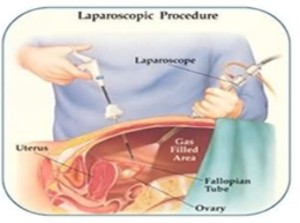The tissue lining the womb or uterus is called the endometrium. When this tissue is found outside the womb or uterus it gets “trapped” within the pelvic area. This condition results in discomfort and pain as symptoms of endometriosis. Most women have this medical condition without exhibiting the symptoms, though, and those who do have them in tolerable levels that they are not even diagnosed.
Diagnosing endometriosis is done only if the symptoms become severe so as to cause intense pain which may not have been alleviated by first line treatments. On a scale of one to ten, between five and ten women develop endometriosis at one point or another in their lives without having them diagnosed. These symptoms begin between 25 and 40 years of age but some begin in adolescence.
“Chocoate” Cysts and Fibroids
 Patches of endometrial tissues have the tendency to become sticky and “glue” other organs together as adhesions. Endometrial cells may later form into cysts which also “bleed” monthly when menstruation occurs.
Patches of endometrial tissues have the tendency to become sticky and “glue” other organs together as adhesions. Endometrial cells may later form into cysts which also “bleed” monthly when menstruation occurs.
These cysts can fill up with dark colored blood commonly referred to as “chocolate” cysts. These should not be confused with fibroids which are benign or noncancerous growths in the uterine muscle tissues.
Some Factors that May Cause Endometriosis to Develop
- Endometriosis is common in blood relatives of the first degree such as immediate family members.
- Because estrogen is essential for the development of endometriosis, it is rare in post-menopausal women; estrogen levels fall right after menopause.
- When some cells from the lining of the womb or uterus are spilled backwards toward the Fallopian tubes during menstruation, the likelihood of developing endometriosis is increased.
- The survival of these endometrial cells and their natural response to estrogen enables them to multiply. Because they are trapped within the pelvic area, however, they cannot be shed during menstruation and thicken instead to develop into endometriosis.
Symptoms of Endometriosis
As mentioned, endometriosis symptoms vary from one woman to another. The number and size of endometrial tissues may be pinhead size or large clumps but it doesn’t necessarily mean that large tissues will result in worse symptoms. Here are the symptoms which may indicate endometriosis:
- Severe pain during menstrual periods: this may begin several days prior to the actual period but could last for the period’s entirety.
- Pain during sex: pain is felt internally during sex and lasts several hours even after it.
- Pelvic pain: pain is consistent in the pelvic area on the days prior to and during the actual period.
- Reduced fertility: the endometrial tissues may prevent the egg’s passage from the ovaries to the Fallopian tubes.
- Blood in the stool.
- Pain in the abdomen during urination.
- Blood in the urine.
Diagnosing Endometriosis
Endometriosis may be confirmed by a medical examination known as a laparoscopy. This involves a small incision (under anesthesia) in the abdominal wall bellow the belly button or umbilicus. A laparoscope, a slim and telescope-like device, is then inserted into the skin to find out if there is presence of endometriosis tissue patches.
A new test in 2009 showed that diagnosis may also be done using biopsy or a sample taken from the lining of the womb or uterus and brought to a laboratory. This procedure may be conducted without the need for surgery like a laparoscopy, an encouraging fact for women who don’t particularly like surgical procedures.
How Endometriosis Progresses
Left untreated, endometriosis will get worse, albeit it is not indicative of any cancerous condition. However, complications often occur with endometriosis which has been left untreated such as obstruction of the tubes which lead from kidney to bladder.
Women who experience only mild pain during the menstrual period and women who have no fertility issues often opt not to treat endometriosis; in three out of ten women, in fact, treatment is sought only if the pain becomes severe even if they know that treatments can help improve symptoms before fertility is affected.
Treatments for Endometriosis
Paracetamol: this is taken when symptoms of pain are mild to moderate. Codeine or codeine combined with paracetamol: although constipation is a side effect from this medication, it can be a potent painkiller. Anti-inflammatory: for pain that extends from moderate to severe, anti-inflammatory medications such as ibuprofen and naproxen are taken.
How Tramadol Works
Tramadol, marketed as Ultram in the U.S. and as Ralivia in Canada, is a prescription medicine approved as treatment for pain for individuals who are 16 years of age and older. Although not deemed a narcotic or controlled substance by the U.S. Drug Enforcement Agency or DEA, the potential for abuse of Tramadol has resulted in its classification by certain states as a controlled substance.
This medication works in the body’s central nervous system by inhibiting reuptake of the brain chemicals norepinephrine and serotonin which send messages decreasing pain perception from the brain to the nerve cells. Because Tramadol is non-addictive, it is relatively safe for use even by people who have previous drug or alcohol abuse issues, albeit in recent times, dependency and abuse have been reported as a result of Tramadol’s morphine-like effects.
Share This